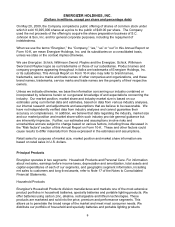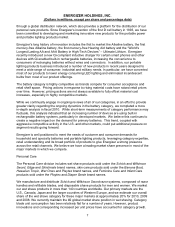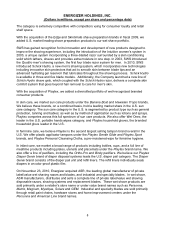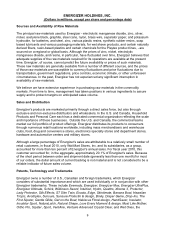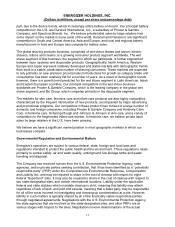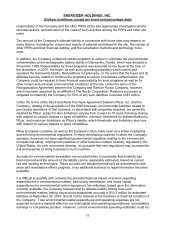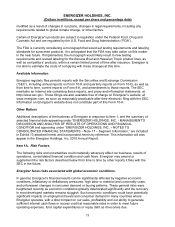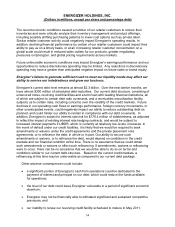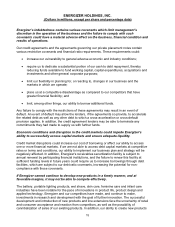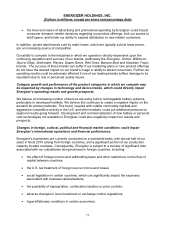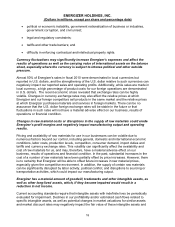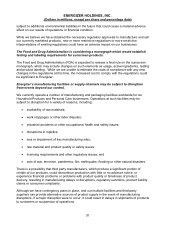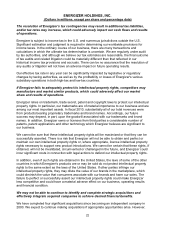Energizer 2010 Annual Report Download - page 24
Download and view the complete annual report
Please find page 24 of the 2010 Energizer annual report below. You can navigate through the pages in the report by either clicking on the pages listed below, or by using the keyword search tool below to find specific information within the annual report.
ENERGIZER HOLDINGS, INC.
(Dollars in millions, except per share and percentage data)
14
The recent economic conditions caused a number of our retailer customers to reduce their
inventories and more critically analyze their inventory management and product offerings,
including possibly shifting purchasing patterns to lower-cost options such as private label.
Similar retailer customer activity could negatively impact Energizer’s operating results. In
addition, declining financial performance by certain of our retailer customers could impact their
ability to pay us on a timely basis, or at all. Increasing retailer customer concentration on a
global scale could result in reduced sales outlets for our products, greater negotiating
pressures on Energizer, and global pricing requirements across markets.
Future unfavorable economic conditions may impact Energizer’s earnings performance and our
opportunities to reduce discretionary spending may be limited. Any reductions in discretionary
spending may have a greater than anticipated negative impact on future sales or brand equity.
Energizer’s failure to generate sufficient cash to meet our liquidity needs may affect our
ability to service our indebtedness and grow our business.
Energizer’s current debt level remains at almost $2.3 billion. Over the next twelve months, we
have almost $300 million of scheduled debt maturities. Our current debt structure, consisting of
unsecured notes, revolving credit facilities and a term loan with leading financial institutions, all
of which are subject to certain debt ratio covenants, and a receivables securitization facility,
subjects us to certain risks, including concerns over the volatility of the credit markets. Future
declines in our operating cash flows or earnings performance, foreign currency movements, or
other unanticipated events, could negatively impact our ability to reduce outstanding debt as
planned, and could hinder our ability to remain in compliance with our debt covenants. In
addition, Energizer is subject to interest rate risk for $178.4 million of indebtedness, as adjusted
to reflect the impact of existing interest rate hedging contracts, and would be subject to
increased interest payments if LIBOR, which is currently at relatively low levels, increases. In
the event of default under our credit facilities, it is likely that we would be required to seek
amendments or waivers under the credit agreements and the private placement note
agreements, or to refinance the debt, in whole or in part. Our ability to secure such
amendments or waivers, or to refinance the debt, would depend on conditions in the credit
markets and our financial condition at the time. There is no assurance that we could obtain
such amendments or waivers or effect such refinancing. If amendments, waivers or refinancing
were to occur, there can be no assurance that we would be able to do so on terms and
conditions similar to our current debt structure. Based on the current credit markets, a
refinancing at this time may be unfavorable as compared to our current debt package.
Other adverse consequences could include:
• a significant portion of Energizer’s cash from operations could be dedicated to the
payment of interest and principal on our debt, which could reduce the funds available
for operations;
• the level of our debt could leave Energizer vulnerable in a period of significant economic
downturn;
• Energizer may not be financially able to withstand significant and sustained competitive
pressures; and
• our inability to renew our revolving credit facility scheduled to mature in May 2011.




